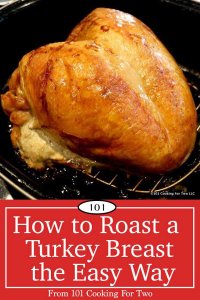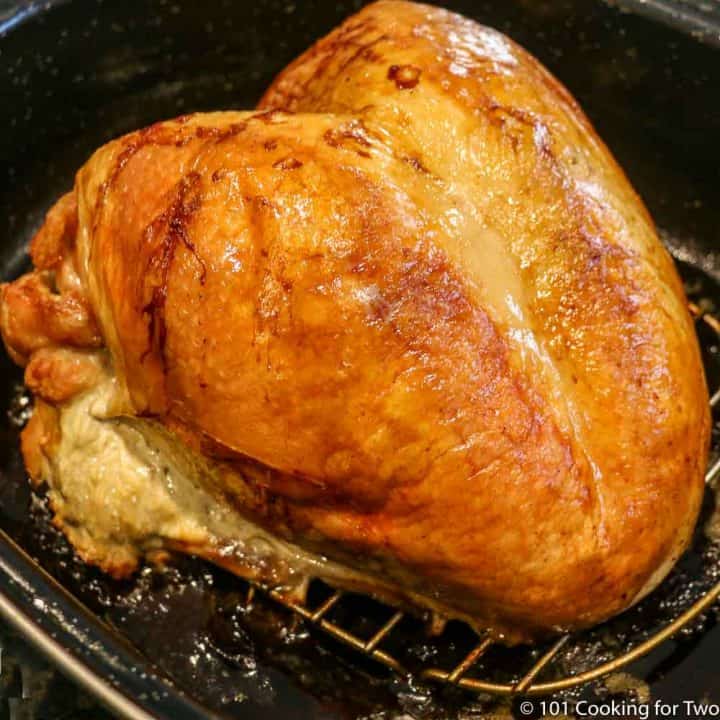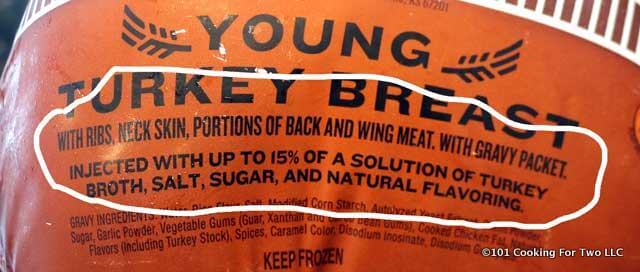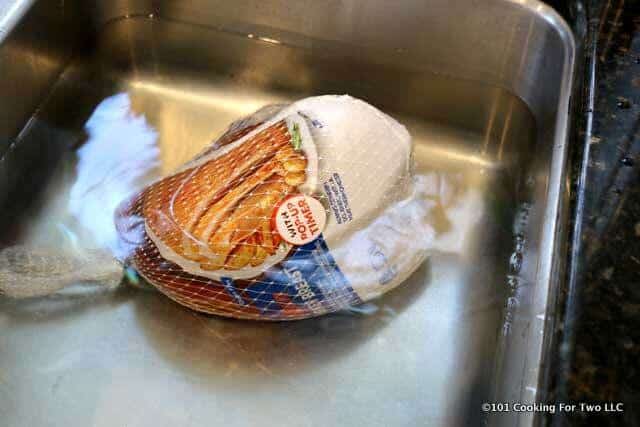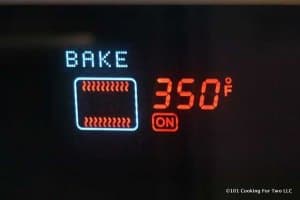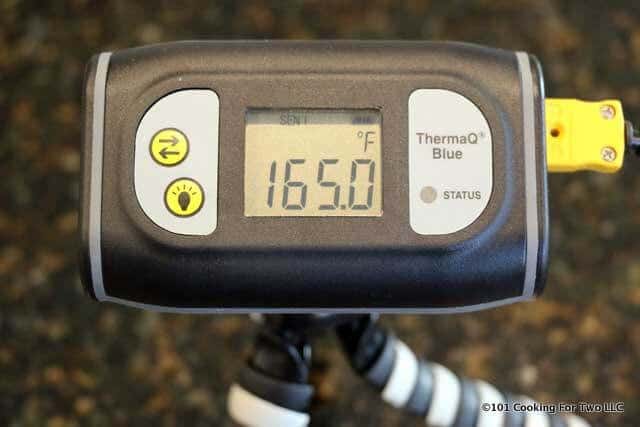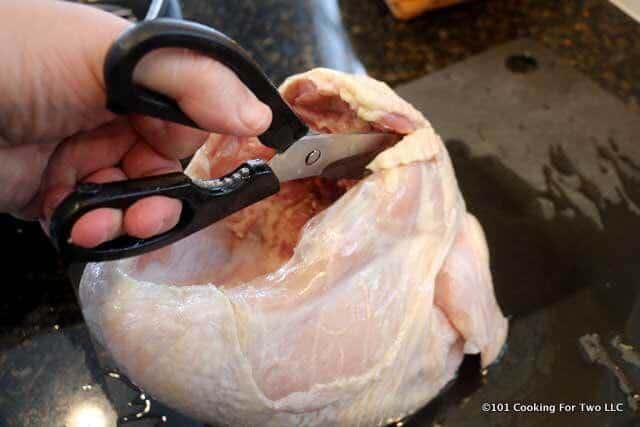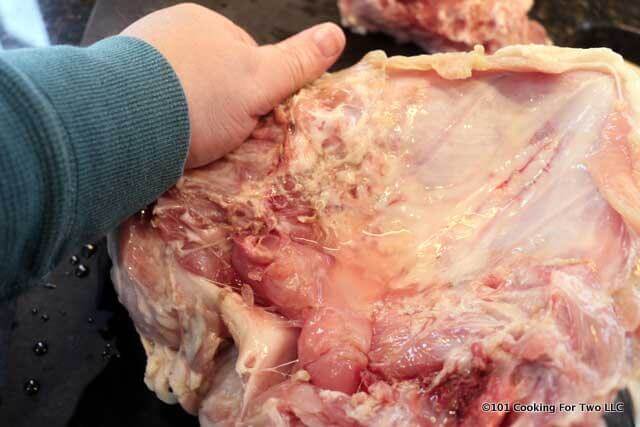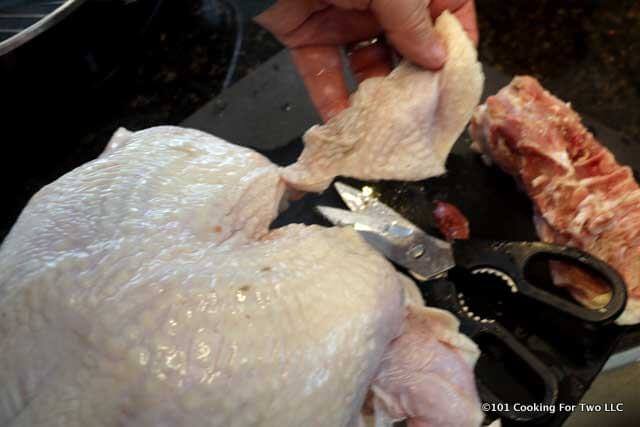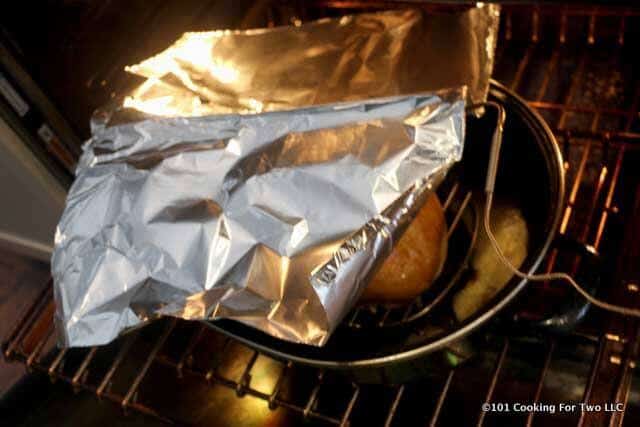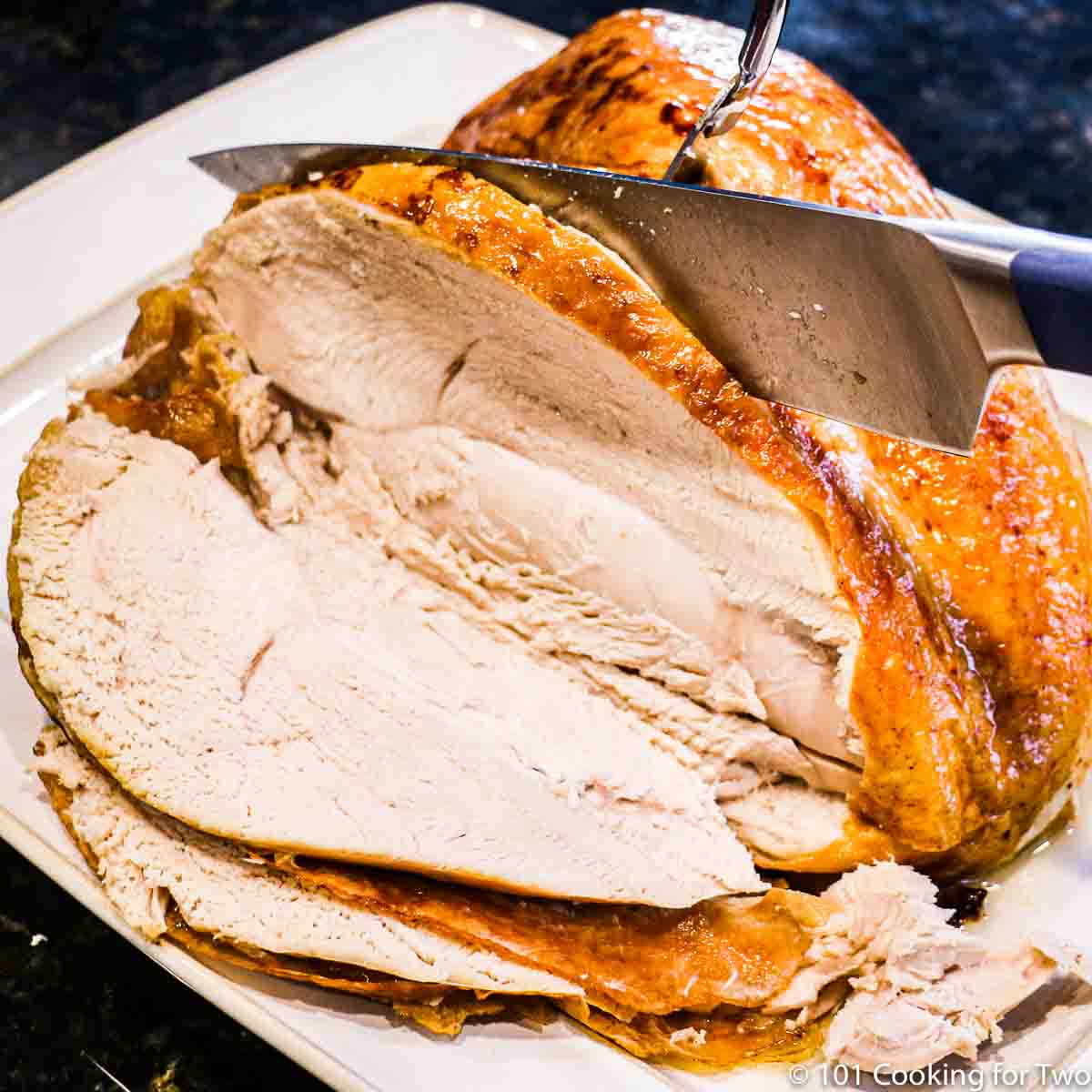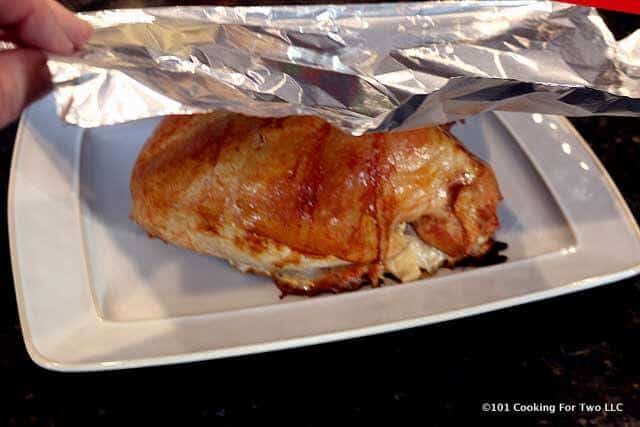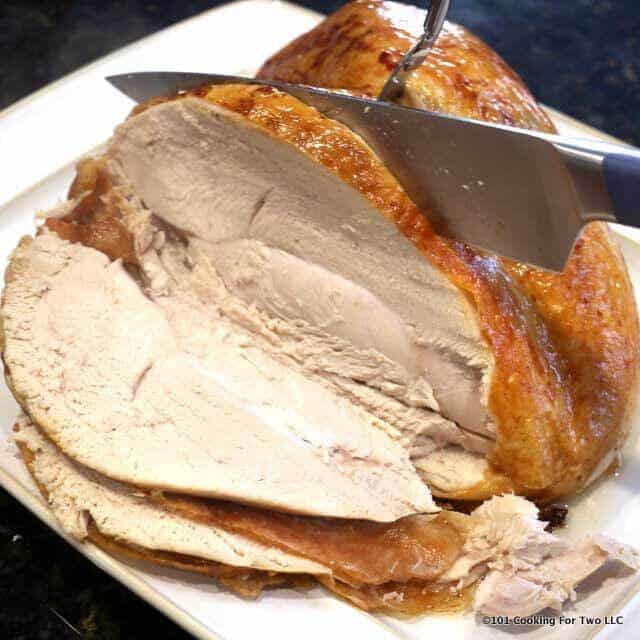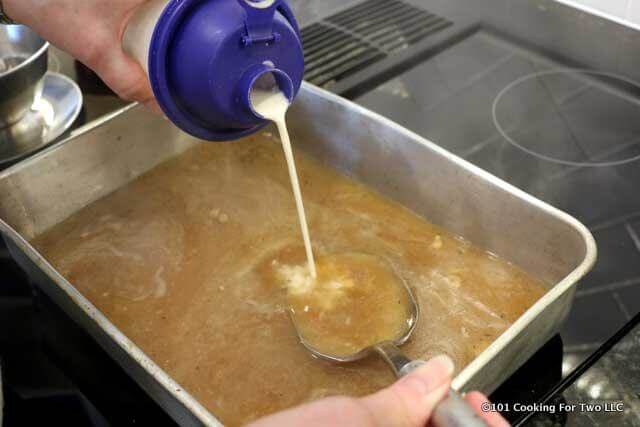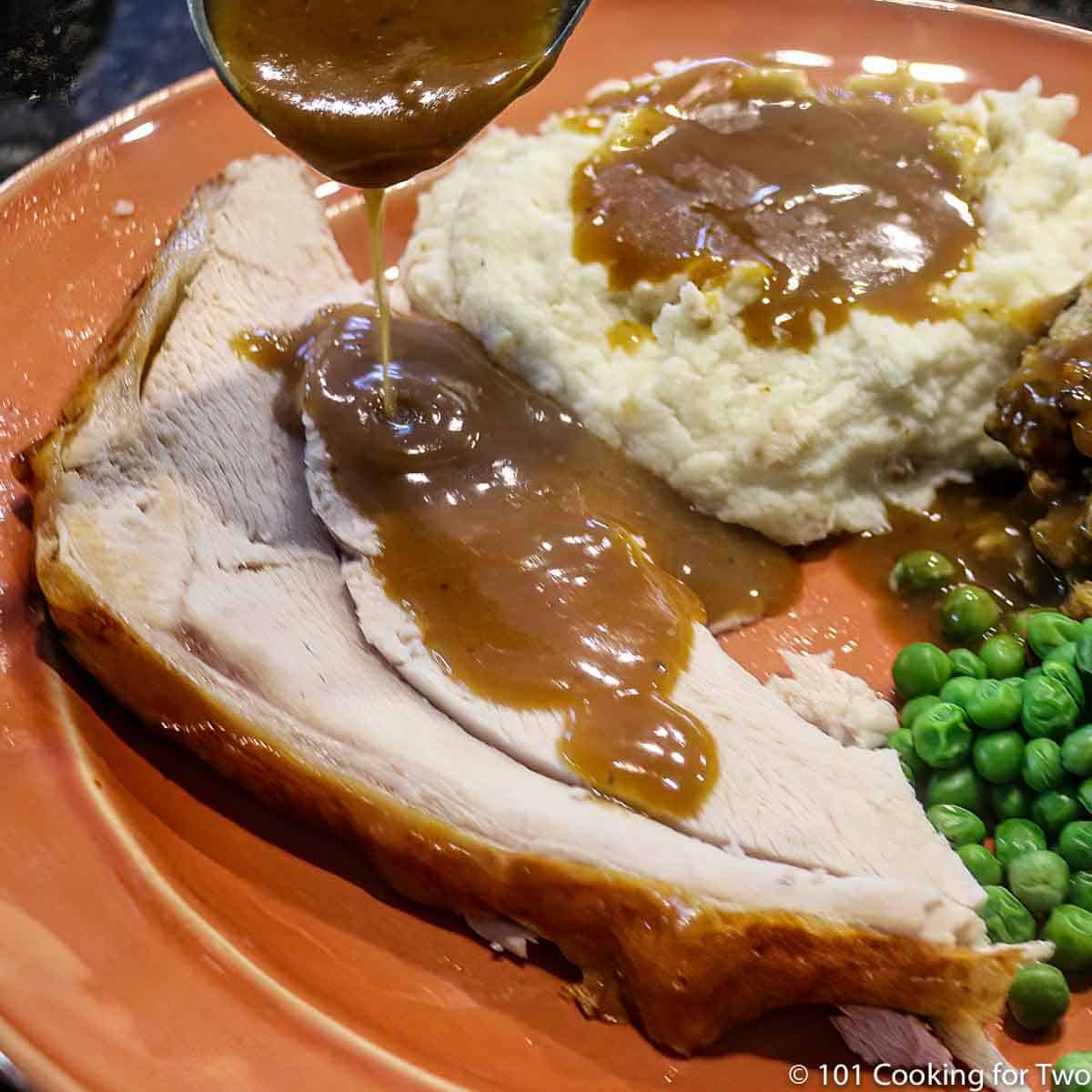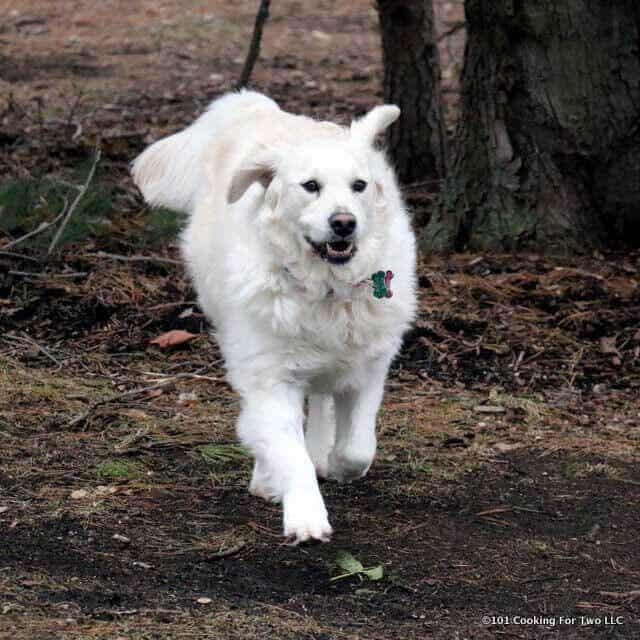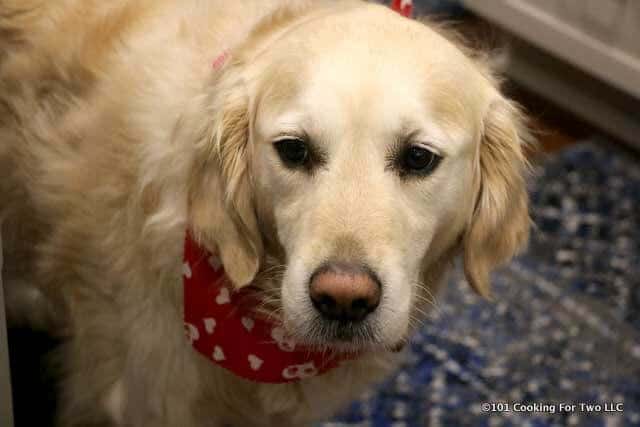Great turkey dinner for the smaller household or as a supplement of white meat for a larger holiday feast. Learn the secrets of cooking a previously frozen turkey breast with this complete guide to moist and tender turkey.
Let’s not make an easy thing hard. Get perfect results the first time and every time with these easy step by step photo instructions. Turkey is a year-round meal now.
I have cooked many turkey breasts over the years and wanted to give you the easiest instructions possible, so you don’t spend the whole day in the kitchen cooking and miss all the family fun.
The “Secrets” of This Easy Recipe.
- Thaw and trim a frozen turkey breast. Learn to do it right.
- Brush with butter or oil. You can add other flavors but not needed.
- Cook at 350 degrees until an internal temperature of 165 and tent if getting too brown. You need a meat thermometer to not get this wrong.
- Rest tented for 15 minutes before carving. Make gravy while resting.
You can do this. But let’s expand on the detail and try to answer any questions you may have.
My Rating
I love turkey, and this is a solid lower 5. It is not filet, and it is not that supped up “Martha Stewart” turkey breast. So not a high 5. You do get something for all that work.
Pro Tips: Notes on How to Roast a Turkey Breast
This is great for what it is, straight up turkey that is moist and tasty. It is reliable, and everybody will enjoy it. A skill level of 2/10 for the turkey and 3/10 for the gravy.
What Turkey Breasts Are We Talking About?
I can not walk into most American grocery stores and buy a fresh turkey breast and especially half of a breast. We will discuss what we usually have available.
I’m talking about that rock hard frozen turkey breast you picked up at your local supermarket. They are injected with a brine solution and flavor enhancers.
Let’s look at that label. It is telling you this breast is “pre-brined” or “injected.” It will be moist and favorable if you don’t screw it up.
You can not brine it, or you will have a salt lick. So let’s not fight it. I don’t care what other recipes say, just don’t.
Some packages will include things like the neck or a gravy packet. They are there to make it weigh more, and you pay more. Toss them. You could have used them to make a broth gravy, but that gets you into the “spending all day in the kitchen” zone.
Can I do this with a fresh not injected turkey breast?
Yep, I feel a turkey breast is better if it is injected or brined. So if you have a fresh turkey breast (which is usually not injected), you can use my method, and you will get a 4.5 on my rating scale.
If you are absolutely sure your turkey is not injected or brined, you can add a simple brine of 1 gallon of water, 1 cup of salt and 1/2 cup of sugar for 12 to 24 hours would be good. For more details see my How to Brine a Turkey for a complete guide.
How Much Turkey to Buy?
I consider the number of servings not quite the same as to how much to buy. The internet will say buy anywhere from 1/2 pound to 1 1/4 pound. In some ways, both are correct to me.
If I’m just addressing per serving, the 1/2 pound seems about right. That is a nice good-sized slice of turkey. But we all overeat turkey and want leftovers.
I’m at a minimum of 3/4 pounds per person, but if you want leftovers, then 1 pound to even 1 1/2 pound per person is what I’m buying. An I will be doing 2 pounds per person this year.
How to Thaw a Turkey Breast?
The preferred method is to thaw in a refrigerator. Place the unopened breast on a tray in the refrigerator for 1½ to 2 days, or until thawed. If you have a breast over 8 pounds, it may take a bit longer.
That is the official recommendation, but it always seems to be a day longer for me. So plan ahead and do not open the sealed package.
To thaw faster, place the unopened breast in cold tap water for 3 to 5 hours. Change water every 30 minutes to keep the turkey in the safety zone which is less than 40 degrees.
NEVER thaw the turkey or any other meat at room temperature. It is not safe.
What Temperature to Cook a Turkey Breast?
The best answer is 350 degrees. But 325 degrees can work, but it will take a bit longer and potentially can dry a little more.
You have two parts you want to cook, the meat and the skin. The skin needs to be exposed to a 350-degree oven for about 1 3/4 to 2 hours to brown well. That is about the cooking time for a 5 to 7# breast.
If your breast is bigger, the meat will not be done when the skin is nicely brown. All you need to do is a tent with foil when the skin is nice. An easy fix.
A frequent recommendation is to start out high at 425 and turn down the temperature to 325 immediately or in 20-30 minutes. This is to get the browned skin. I don’t see it as needed since you will just end up tenting longer. I feel 350 is a much better choice.
What Final Temperature Do You Need?
Again an easy answer, 165. That is the safe final internal temperature according to the FDA. That will give you a safe, moist, and tender turkey.
I stop right at 165. Some will stop at 160 and assume the breast will reach 165 during the rest. It probably will. I prefer to know I’m serving safe food. For more turkey safety points see my Thanksgiving Food Safety post.
All this should tell you that you must be able to check the internal temperature of the breast accurately. You and use many different options but you must have something.
I used my ThermaQ Blue from Thermoworks. I use it a lot for grilling with the two probes for surface and meat temperature. But it works great indoors cooking, also. See The Cooking for Two Shop if you are interested.
How Long to Cook a Turkey Breast?
16-20 minutes per pound is a great estimate at 350 degrees. But the real answer is as long as it takes to get to 165 degrees in the thickest part. Not very helpful for your timing.
So to write this, I cooked two turkey breast at 350 degrees. The 9+ pound breast took about 2 1/2 hours which was 16.5 minutes per pound and the second 5+ pound took 20 minutes per pound.
These numbers are consistent with my previous experience and other recommendations. So now you can estimate time but remember you are cooking to a final temperature and not by time alone.
How About the Gravy?
Of course, you want gravy, but the most common way to make gravy uses a roux. For the 4 cups of gravy I’m suggesting, that would require 1/2 cup of fat. You just don’t have that here since there are almost no drippings with a turkey breast.
So I’m using a slurry method to make the gravy. We whisk about 1/2 of the liquid with about 2 tablespoons of flour for every cup of gravy we are making. That is added to boiling fluid and mixed slowly. More details at How To Make Gravy at Home
I can rarely find turkey broth in the store, so I usually use Penzeys turkey base, but chicken broth will work well.
Other Questions:
Butter vs. Oil on the skin of the turkey?
This is a “does it really matter” questions. The answer, maybe a little. Most recipes use butter. I feel mostly by default, and that is just “the way it is done.”
Arguing against butter is like arguing against bacon. But I want a crisper skin. According to 52 Food, you will get that with oil more than butter.
Moisture is the enemy of crispy so a good pat dry with paper towels and using oil and not butter which is 20% water. Clarified butter is another option.
Do I have to use a meat thermometer? Yes, or you will undercook (dangerous) or overcook (dried out).
How often should I baste? Basting is not really needed. I like to rotate the breast once during the roasting to account for any oven hot spots, and I brush it at the same time.
Can I stuff it? No, it is not safe. The stuffing would need to get to 165 degrees to be safe and the meat would overcook.
Do I have to use a rack? No, but it is nicer. But there is not the volume of drippings you have with a whole turkey. If no rack then a good spray of PAM on the pan.
Other Turkey Recipes
Butter Turkey Tenderloin; Pan Seared Oven Roasted with Gravy
Grilled Turkey Breast
Cider Brined, Herb Buttered Roasted Turkey – The Full Monty
How to Brine a Turkey
Other Recipes for a Complete Meal
Easy Sausage Stuffing
Traditional Sweet Potato Casserole
Green Bean Casserole Without Soup
See Thanksgiving Menu Planning Time for my complete holiday recommendations updated yearly.
Fully thaw the turkey breast before proceeding. Preheat oven to 350 degrees with a rack set at the lower third in the oven. No convection needed here.
Remove any bags of things. Cut out the backbone if present. If a popup timer is present, pay it no attention but do not remove.
Break back the rib sections, so you have a flat bottom to set on a rack. You can skip this if you are using a V-rack.
Cut back any extra skin like the neck area. Pat dry with paper towels.
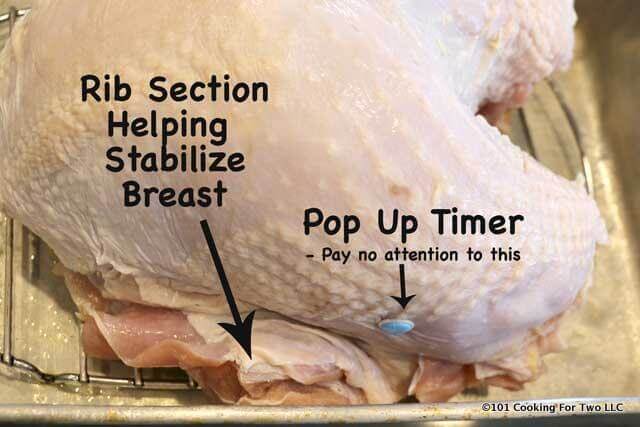
Smaller breast in a cake pan
Place a rack in an appropriate size pan. For a large 7 plus pound breast use a full roasting pan. For the smaller breast, a cake pan will do. Spray the rack with PAM. Place the breast on the rack and spread the rib sections to stabilize the breast.
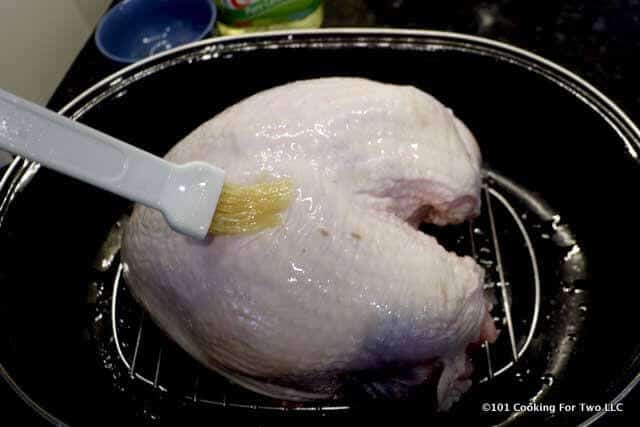
Larger breast in full roasting pan
Give it a bush with vegetable oil or melted butter. You can give it a sprinkle of salt at this point.
Place in oven. Leave it alone for 1 hour then rotate 180 degrees and brush with oil or butter. Check the color at about 1 1/2 hours to 2 hours. If the skin is becoming too brown, tent lightly with foil while finishing roasting to prevent further browning.
Roast until an internal temperature of 165 in the thickest part. This will be between 16-20 minutes per pound usually. Variability is caused by the thickness of the breast, the starting internal temperature of the breast and your oven.
Remove from oven and tent. The internal temperature will rise 5-10 degrees.
Tent for about 15 minutes before carving.
While turkey is resting, whisk 2 cups of turkey or chicken broth with 1/2 cup of flour. Add 2 cups more of broth to the roasting pan and any drippings present, place over medium-high heat and bring to boil. Decrease the heat to medium and then slowly add the broth-flour mixture while continuously whisking. Add most of it and add more later if needed. Add salt to taste. Once thickened, cook an additional few minutes.
Do you want more recipes from 101 Cooking for Two? Sign up for the newsletter and get all posts delivered straight to your inbox!
If you enjoyed this recipe, the pleasure of a rating on the recipe card below is requested.
How to Roast a Turkey Breast with Gravy
Great turkey dinner for the smaller household or as a supplement of white meat for a larger holiday feast. Learn the secrets of cooking a previously frozen turkey breast with this complete guide to moist and tender turkey.
Prep Time10 mins
Cook Time2 hrs
Total Time2 hrs 10 mins
Servings/Adjust Amount: 12
12
Ingredients
- 6 pounds turkey breast
- 1 tablespoon oil – or butter
For Gravy
- 1/2 cup flour
- 4 cups broth – turkey or chicken
- salt to taste
Instructions
-
Fully thaw the turkey breast before proceeding. Preheat oven to 350 degrees with a rack set at the lower third in the oven. No convection needed here.
-
Remove any bags of things. Cut out the backbone if present. If a popup timer is present, pay it no attention but do not remove it.
-
Break back the rib sections, so you have a flat bottom to set on a rack. You can skip this if you are using a V-rack.
-
Cut back any extra skin like the neck area. Pat dry with paper towels.
-
Place a rack of the appropriate size pan. For a large 7 plus pound, breast use a full roasting pan. For the smaller breast, a cake pan will do. Spray the rack with PAM. Place the breast on the rack and spread the rib sections to stabilize the breast.
-
Give it a bush with vegetable oil or melted butter. You can give it a sprinkle of salt at this point.
-
Place in oven. Leave it alone for 1 hour then rotate 180 degrees and brush with oil or butter. Check the color at about 1 1/2 hours to 2 hours. If the skin is becoming too brown, tent lightly with foil while finishing roasting to prevent further browning.
-
Roast until the internal temperature of 165 in the thickest part. This will be between 16-20 minutes per pound usually. Variability is caused by the thickness of the breast, the starting internal temperature of the breast and your oven.
-
Remove from oven and tent. The internal temperature will rise 5-10 degrees.
-
Tent for about 15 minutes before carving.
-
While turkey is resting, whisk 2 cups of turkey or chicken broth with 1/2 cup of flour. Add 2 cups more of broth to the roasting pan and any drippings present, place over medium-high heat and bring to boil. Decrease heat to medium and then slowly add the broth-flour mixture while continuously whisking. Add most of it and add more later if needed. Add salt to taste. Once thickened, cook an additional few minutes.
Recipe Notes
Pro Tips:
- Never thaw at room temperature. Place the unopened turkey breast on a tray in refrigerator for 1½ to 2 days, or until thawed. To thaw faster, place the unopened breast in cold tap water for 3 to 5 hours. Change water every 30 minutes to keep turkey cold under 40 degrees for safety.
- You can brine if you are absolutely sure your turkey has not been injected or previous brined.
- Use a 350-degree oven. Lower the rack to have breast in the center of the oven.
- Brush with either oil or melted butter.
- Use a meat thermometer and remove from oven when the internal temperature is 165 in the thickest part.
- Use foil to tent the breast in the oven if the turkey is getting too brown and use foil again after removing from the oven.
- Tent and let rest for 15 minutes before cutting.
- Nutrition is calculated on 1/2 pound servings and 1/3 cup of gravy.
Check Out Other Great Recipes
Calories: 294kcal | Carbohydrates: 4g | Protein: 45g | Fat: 11g | Saturated Fat: 0.2g | Polyunsaturated Fat: 0.1g | Monounsaturated Fat: 1g | Cholesterol: 142mg | Sodium: 788mg | Potassium: 7mg | Fiber: 0.2g | Sugar: 2g | Calcium: 40mg | Iron: 3.1mg
Nutrition is generally for one serving. Number of servings is stated above and is my estimate of normal serving size for this recipe.
All nutritional information are estimates and may vary from your actual results. This is home cooking, and there are many variables. To taste ingredients such as salt will be my estimate of the average used.
First Published March 25, 2018. Refreshed with additional information and updated photos over time.
